
Miraflores and a pile of mud
Miraflores is an exclusive district in Lima, like Chelsea in London, Saint-Germain in Paris, Hietzing in Vienna or Djursholm in Stockholm. In all those areas you find rich or very rich people living, you find the best hotels, the most elegant restaurants and quality shops. I am sure you understand what I mean.
Imagine now, that you live in such a district. All would be very well, were there not a pile of mud in the middle of it. And it is not a small pile. It has an area of 500 x 100 meters and is no less than 22 meters high. This was actually the situation in Miraflores, Lima.
Probably you won't not be surprised to hear, that they wanted (and some non-cultural people still want) that the government should remove all that shit. And of course, looking at the picture to the right, it isn't a very pretty sight. And it wasn't really somewhere in the outskirts - no, it was in the middle of the district.
Well, actually the city started removing part of it, forty years ago.
|
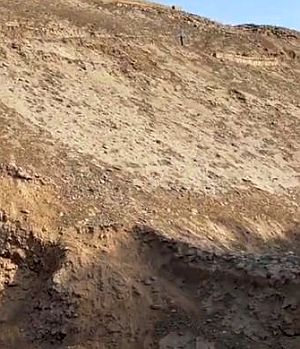 |
Though it were not cleaning workers, but archeologists, who started the cleaning up. And what a pearl lay hidden under the spoils, with which the centuries of time had covered the Huaca Pucllana ... The experts say, that today it is only one third, that is excavated and that it will take at least another fifty years to finish the work.
This ancient pyramid, because that is what it is, is a remnant of a very old culture, the Lima culture. It was not as well known as the big contemporaneos cultures of Moche to the north or Nazca to the south, but it was nevertheless an independent civilization, which evolved about the year 200 AD. It would roughly exist during the next half millennium.
The three rivers in the area, the Chillon, Rimac and Lurin, made it possible to irrigate the surrounding soil, so that some agriculture could complete the living that people made out of fishing. There were some independent villages within the area of today's Lima and each of them had its own religious center. One of the most famous of those is probably the Pucllana, which originates from about 400 AD. A wall separated the secular part from the pyramid, which was entirely dedicated to religious functions. This was called "waka" or "huaca" in Spanish, meaning "sacred".
|
When the excavations started, they revealed how the building was constructed. It was built with handmade adobe or clay bricks, which were not baked, but dried in the sun. The mud was mixed with broken seashells and the like, in order to make it steadier. Alltogether there are seven levels or seven platforms, which were built throughout time. Have a look at the picture to the right and then imagine the dimensions of the entire pyramid ... Every tile is a good twenty centimetres high.
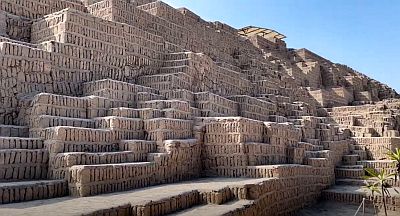
|
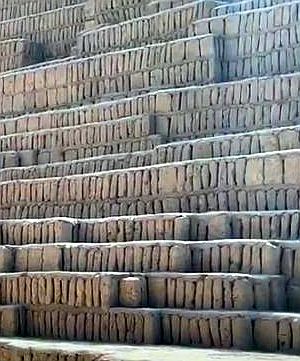 |
The task is almost beyond imagination, because there are millions of them. Moreover they are not put tightly together, but have spaces between each other, in order to make the pyramid safe for earthquakes. Building in this way is called library technique, as it looks lika a bookshelf with a lot of books in it.
There are still today many earthquakes in that area. Our excellent guide, Vanessa Vasquez, told us, that the people almost don't react to earthquakes nowadays, because, there are so many. Of course, if the Americas still drifts westwards, the coast line is mostly endangered. We know this as well from the San Francisco area on the western part of the northern hemisphere.
|
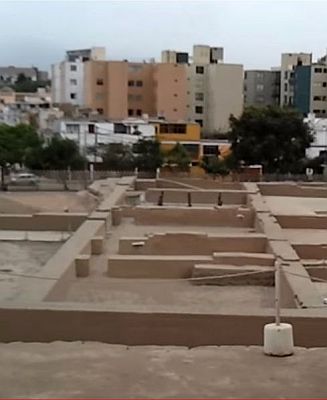 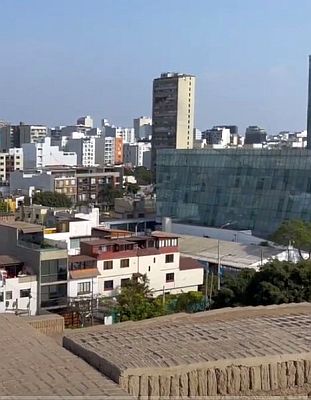
The pictures above give you an idea of how integrated the pyramid is in the surroundings. The left one is from the second level and the image to the right is from the top.
Three years after the excavations had begun, a museum was established, where the findings are exposed to the public. As the work goes on, every year more artifacts are included. Today the site is part of the National Culture Heritage of Peru. Interestingly this enormous monument is not part of the UNESO World Heritage ...
Many of the artefacts have been decorated with motifs from the sea, either with symbolized waves, like the pot to the right, or with sea animals.
There were three different kinds of religious rituals. One, that doesn't sound very pleasant for our time, was the human sacrifice. Mostly it were young women, between the age of twelve and twentyone, who were offered to the Gods, mainly to the Seagodess Mama Cocha. They were given drugs, so they wouldn't have to suffer, before they were killed.
|
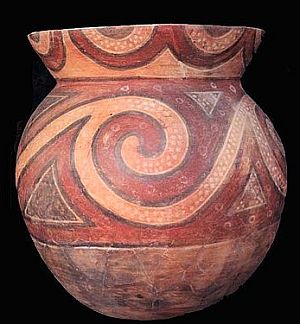 |
I agree, it sounds very cruel, but on the other hand it was the religious culture of that time. And just don't tell me, that the conquistadores and the priests, following them, were less cruel in the name of Christianity. And that is not so very long ago. Or think of all the methods the inquisition used against its own people, think of the witch burnings - all in the name of religion - before you condemn the rituals of other cultures.
In our eyes the ruining of big jars is not very understandable either. But probably it was part of the same belief - that you must give to the Gods, what is most dear to you, in order to be accepted by them. Even on this pot you can see the drawing of a fish, a shark.
The third ritual is more understandable. There were feasts and the main focus was the eating of sharks. We must not forget, that it was a marine culture and the sharks probably a very tough enemy of the fishermen. Whether they feared or adored the sharks as Deity, does not matter. Eating their flesh was either revenge for a lost society member or the belief to become part of this Deity - just like catholics eat the oblate, that is said to be the flesh of Christ.
|
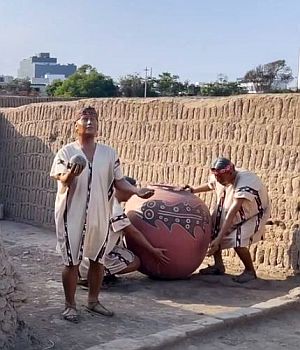 |
The rituals were mostly celebrated when there was a big change in the lives of the community. That could have been a new leader or even a new part of a building, and on occasions like that.
The Lima culture used mainly three colours, namely red, black and white, though the temple walls were painted in yellow.
There are also hundreds of small dimples in the ground of the platforms. The reason probably were offerings. The archeologists found several artefacts in the holes, like seashells or miniature dolls made of clay, and such things alike.
|
When the Lima culture was abandoned, for whatever reason we don't know, the Wari people took over. They originated near today's city of Arequipa and spread to the north. The Wari used the highest levels of the pyramid as a burial place, either as a single tomb or for groups. It were only highly ranked members of the society, who were buried there. The deceased were wrapped into all kinds of textiles, to form a so called bundle and put into cavelike roofed openings in the pyramidal structure. You can see one of them in the picture to the right.
|
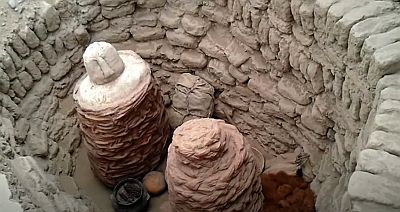 |
|
There are not many left, as the following civilisation removed them. Those were the Ychsma, their culture starting from about the year 1000.
|
Copyright Bernhard Kauntz, Västerås 2022
Back to  or to the or to the  of of 
last update: 29.8.2022 by webmaster@werbeka.com
|





